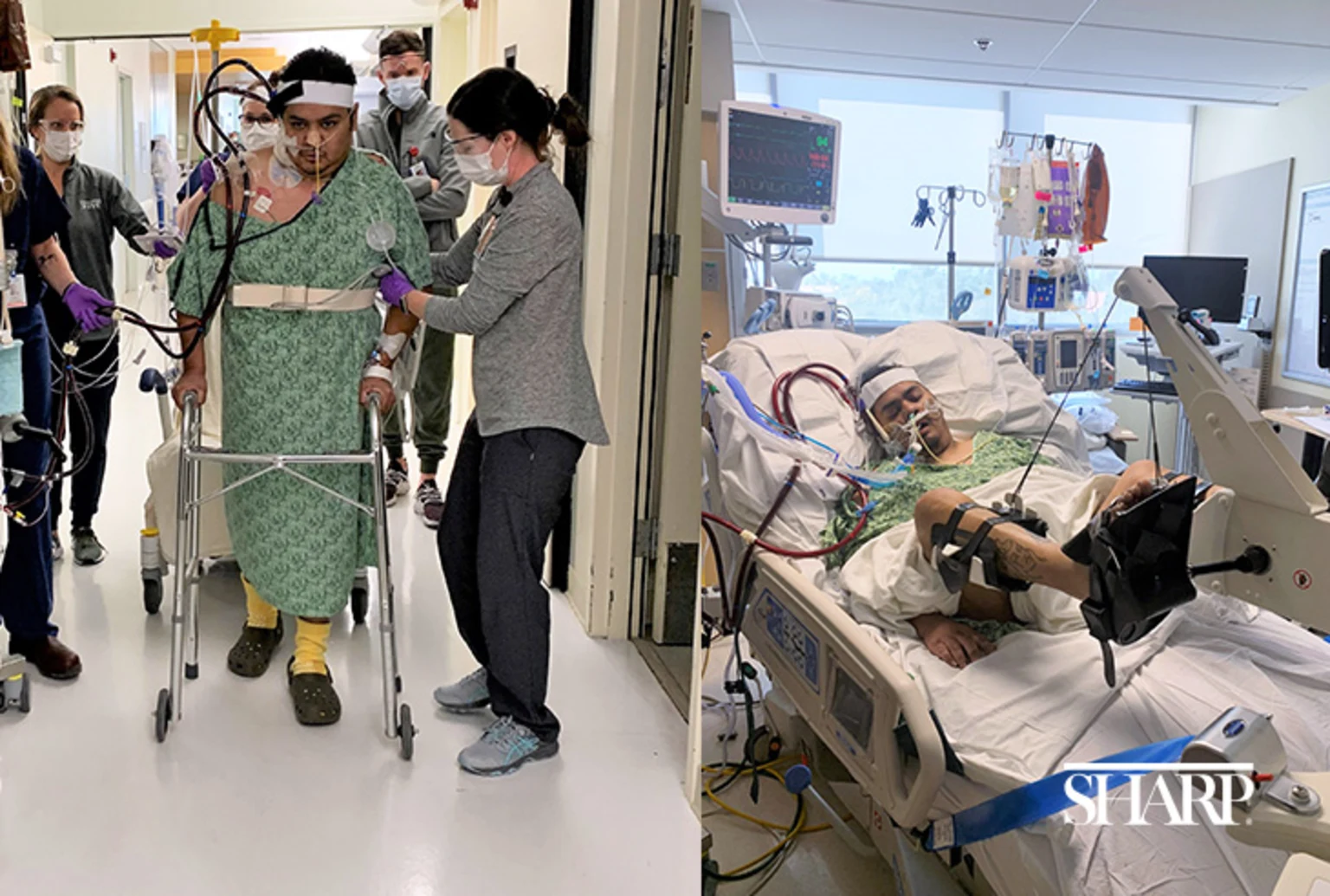
Saipan to San Diego: Global Patient Services in action
After a life-changing injury in Saipan, a young man’s journey to recovery takes him thousands of miles to San Diego.
Danny Plata looked like any other fan at Petco Park during a recent San Diego Padres home game - cheering in the stands as he proudly wore the team's white and gold jersey.
But Danny's mere presence at the game - and the group he was with - was anything but ordinary. The Sharp Chula Vista Medical Center emergency room (ER) nurse had invited dozens of other Sharp clinicians to the game. All of them had helped save his life earlier this year from a near-deadly case of COVID-19.
"As an ER nurse, I know what it's like to care for someone and not know how they end up," says Danny, who arranged to have his caregivers' names featured on the ballpark scoreboard during the third inning. "I wanted them to see how I was doing, to see how grateful I continue to be for all they did for me and my family."
Danny, age 38 and a father of 2 children, was hospitalized in the intensive care unit at Sharp Memorial Hospital in mid-January 2021, during the height of the winter surge. He was placed on a ventilator to help him breathe, but quickly needed extracorporeal membrane oxygenation (ECMO). The ECMO device serves as an artificial lung - it removes blood from the body, clears it of carbon dioxide and adds in oxygen, then pumps the refreshed blood back into the body. ECMO is often the last option for patients with severe COVID-19.
Danny was kept on ECMO in a medically induced coma for several weeks to give his lungs a chance to heal. Yet, his prognosis remained grim - so much that his children were advised to say their goodbyes. Then, a cardiac surgeon at Sharp Memorial had an intriguing idea.
An innovative approach
Dr. Walter Dembitsky, formerly at Sharp, performed cardiovascular surgery at Sharp Memorial for nearly 40 years. In the 1980s, he brought ECMO to San Diego for the first time for patients with lung failure, and then for patients with heart failure. About a decade ago, he helped transition the technology to the ER, where it can be used on patients experiencing severe heart or lung conditions, including those who come to the ER after having a cardiac arrest outside of the hospital.
As Danny lay in his hospital bed, not recovering, Dr. Dembitsky lectured at a virtual conference with doctors from around the world who were treating COVID-19. There, he learned about a promising approach to ECMO treatment that was being trialed on patients with severe COVID-19 at Rush University Medical Center in Chicago.
The technique involves a novel way of using a single catheter to remove blood from the heart, send it through the ECMO machine, and then return it directly into the main artery that connects to the lungs.
This approach is combined with a concerted effort to reduce the strong medications that keep patients in a coma. Patients regain consciousness, then are weaned off the mechanical ventilator. Even when they are "awake," patients are still unable to breathe on their own. So, they remain connected to the ECMO machine, which continues to act as an external lung while the patient's actual lungs slowly recover.
"Ventilators save lives, but they can significantly impact the body and damage the lungs," Dr. Dembitsky said. "You're essentially paralyzed when you're sedated; you don't move a muscle for days to weeks to months. It made sense to me that if we could safely get these patients off the ventilator - even while on ECMO - we could strengthen their breathing muscles and even get them walking, which could speed up their recovery. Essentially, we begin the long road of physical and mental rehabilitation while patients are still on ECMO."
Danny's care team - including doctors, intensive care nurses, specially trained ECMO nurses, respiratory therapists, pharmacists and physical rehabilitation therapists - all jumped at the opportunity to try this approach, which had never been attempted in San Diego on a patient with COVID-19. It was especially meaningful for them to help save a colleague's life, Dr. Dembitsky said.
The team received direct training and guidance from clinicians at Rush as they implemented the new strategy and slowly woke Danny up.
'It was hard not to panic'
At first, Danny knew he was in a hospital, but couldn't figure out why. He didn't remember that he had COVID-19, or even that there was a pandemic. His head hurt and he could feel the ECMO tube coming out of his neck, though he didn't know what it was. He thought he'd been mugged.

While on the ECMO machine, Danny began exercising with bicycle pedals in bed to rebuild his atrophied muscles and went for his first walk down the hallway of the intensive care unit.
Things got tougher as he gained more consciousness. One reason patients remain sedated while on a ventilator is because the machine takes over the job of the lungs. Patients can't breathe on their own, which goes against every human survival instinct.
"It was hard not to panic," Danny says. "I had to continuously and consciously tell myself to relax and let the machine breathe for me."
Through this experience, Danny believes being a nurse was both a curse and a blessing. He knew how close he'd been to dying, how sick he still was and the number of major challenges ahead of him. But he also understood what was needed in order to see his children - Yolanda, age 18, and Daniel, age 11 - again.
While still on the ventilator and ECMO machine, Danny began exercising with bicycle pedals in bed to rebuild his atrophied muscles and improve his lung function. Once the ventilator was removed and he gained some strength, Danny went for his first walk down the hallway of the intensive care unit - flanked by a dozen members of his care team, with ECMO tubes protruding from his neck and the ECMO machine beside him on a rolling cart.
"It was pretty surreal," says Dr. David Willms, one of Danny's intensive care doctors at Sharp Memorial. "I've taken care of a lot of patients with tubes coming out of their bodies, but none of them were up and walking around. They were lying in bed, completely sedated. That being said, it wasn't shocking. I knew the team could do this."
Through it all, Danny leaned on the support of his care team, particularly his intensive care nurses. Because visitors still weren't allowed in the hospital, they decorated his hospital room with family photos. They brought him a Padres hat, a Padres blanket and a jersey of his favorite player, Fernando Tatis Jr. They kept him calm when the challenges of his recovery seemed insurmountable and cheered with him at each success.
Eleven weeks after he was hospitalized, Danny's lungs recovered enough to no longer need ECMO, and the machine was gradually turned off. While most patients who remain on ECMO for such a long time need extensive physical therapy after their hospitalization, Danny walked out of Sharp Memorial only 10 days later, to the cheers of Sharp team members and into the arms of his children, family and friends.
Recovery continues
Danny's incredible story will forever change how Sharp Memorial cares for critically ill patients on ECMO, Dr. Willms says. The ability to wake patients up, free them from the ventilator and get them moving will enhance their recovery and lead to better outcomes. This approach has also been successful with several other patients recovering from severe COVID-19, he says.
As for Danny, transitioning back to real life after a near-death experience and 84 days in the hospital hasn't been easy. He remains on oxygen as his lungs continue to recover. He's trying to catch up on lost time with his children. He's not sure when he'll be well enough to return to the nursing job that he loves.
Those worries were far from his mind during the game at Petco Park. It was a night of laughter, a few tears and lots of healing, he says.
"They took care of me when most people would have given up," Danny says about his Sharp Memorial care team. "They pushed hard. I will forever be grateful."

Our weekly email brings you the latest health tips, recipes and stories.